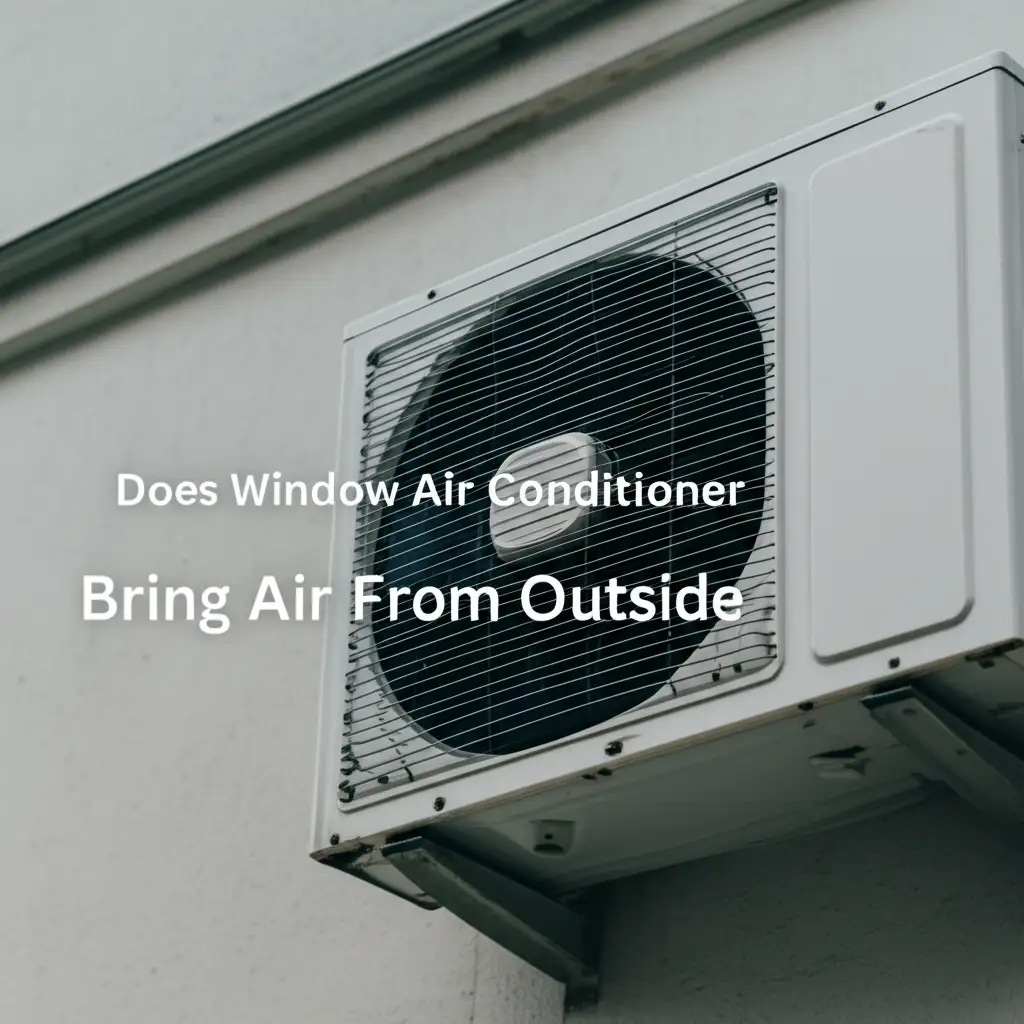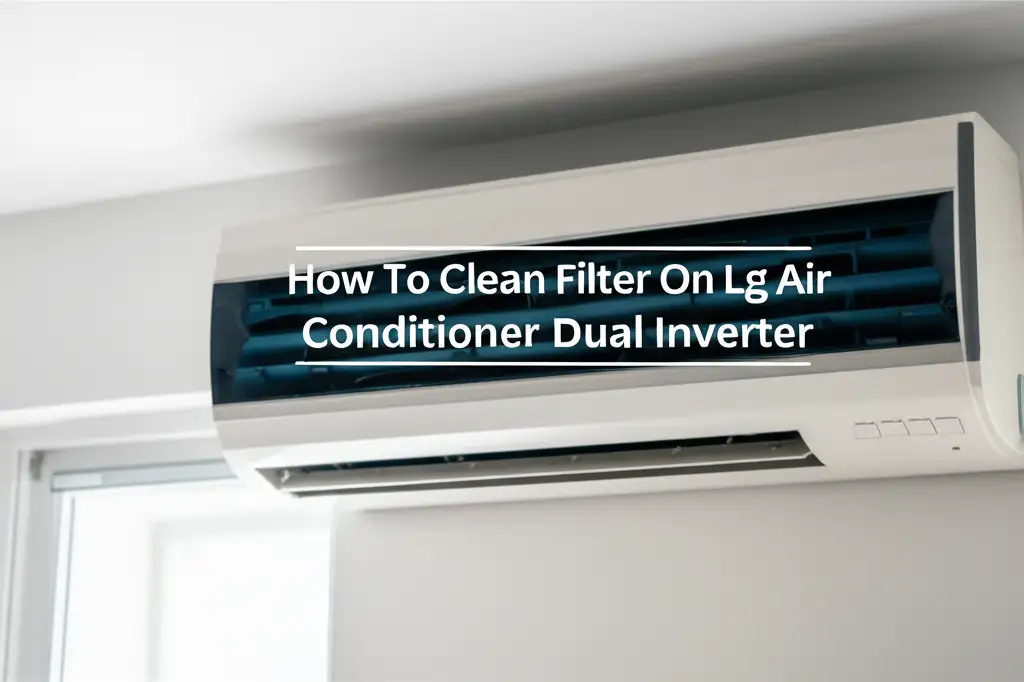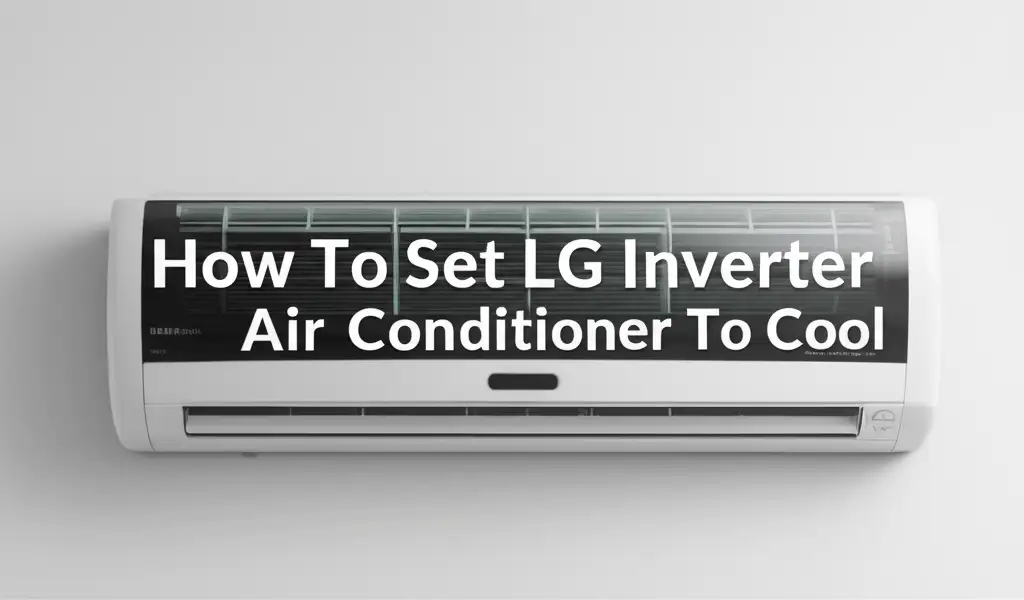· Davia Murnell · Home Appliances · 23 min read
Does Window Air Conditioner Bring Air From Outside

Does Your Window Air Conditioner Bring Air From Outside?
Many people wonder if their window air conditioner unit brings in fresh air from the outdoors. Understanding how these appliances work helps you manage your indoor environment better. We often think of ACs as simply cooling devices, but their interaction with outside air is more nuanced. This article explores the precise function of your window AC regarding external air intake. We discuss the purpose of the fresh air vent, its impact on air quality, and energy efficiency. You will learn how to use your unit effectively to balance comfort and indoor air freshness.
Takeaway:
- Most window AC units primarily recirculate indoor air for cooling.
- Many units have a “fresh air” or “vent” lever for limited outside air intake.
- Using the fresh air vent can improve indoor air quality but increases energy consumption.
- Proper sealing around the unit is crucial to control unintended air infiltration.
- Regular maintenance ensures optimal air circulation and cooling performance.
Most window air conditioners are designed to cool the air inside a room by recirculating it. They do not continuously pull large amounts of outside air into your home. However, many models include a small “fresh air” or “vent” lever. This lever, when opened, allows a limited amount of outdoor air to mix with the indoor air.
The Core Function of Window AC Units: Recirculation vs. Fresh Air Intake
Window air conditioners primarily function by cooling the air already present in your room. The unit draws warm indoor air over a cold evaporator coil. This process removes heat and moisture from the air. The now-cooled air is then blown back into the room. This design prioritizes cooling efficiency and humidity control.
The system works in a closed loop. Air moves from your room into the unit, gets cooled, and returns to your room. This constant recirculation is how the unit efficiently lowers the temperature. If the AC unit constantly pulled in hot, humid air from outside, it would work much harder. This would greatly reduce its cooling capacity. It would also increase its energy use.
Think of it like a refrigerator. A refrigerator cools the air inside its sealed compartment. It does not pull in warm kitchen air to cool. Similarly, a window AC focuses on conditioning the existing indoor air. The main goal is to cool your space effectively and keep energy costs down. Understanding this core function is key. It helps you grasp why outside air intake is usually a limited feature.
Many people mistakenly believe window ACs are like exhaust fans. They are not. Their primary job is to cool and dehumidify your indoor air. They achieve this by cycling the same air repeatedly through the cooling coils. This design is highly efficient for targeted room cooling. It minimizes the energy needed to process new, untreated air. The design also helps prevent outdoor pollutants from entering your home.
The sealed nature of modern AC units is crucial. It prevents unintended air leaks. Air leakage can defeat the purpose of cooling. Proper installation helps maintain this seal. This ensures the unit cools your room and not the outside environment. It also means you control how much, if any, outside air enters.
Understanding the “Fresh Air” or “Vent” Lever on Your Window AC
Many window air conditioners come with a specific control, often labeled “Fresh Air,” “Vent,” or “Exhaust.” This lever or switch does allow for some interaction with outside air. It is important to understand its purpose and limitations. This feature does not mean your AC is constantly bringing in fresh air. It provides a way to introduce a small amount of outdoor air.
When you open this vent, a small damper within the unit shifts. This allows some outdoor air to be drawn into the system. This incoming air mixes with the recirculated indoor air. The fan then blows this mixture into the room. The amount of air exchanged is typically small. It is not enough for full home ventilation. It aims to dilute stale indoor air.
The “Fresh Air” setting is different from “exhaust” or “air exchange” modes found on some models. An exhaust mode actively expels indoor air outside. This creates negative pressure, pulling in replacement air through gaps in your home. A “vent” or “fresh air” lever typically just introduces a small amount of outdoor air. It does not actively push indoor air out. It primarily helps remove odors or reduce stuffiness.
Using this lever means the AC unit must work harder. It needs to cool both the recirculated indoor air and the warmer, more humid outdoor air. This extra effort consumes more energy. Consequently, your electricity bill may increase. For optimal energy efficiency, the fresh air vent should remain closed. Only open it when you specifically need to refresh the air.
This feature is a supplement to cooling, not a primary ventilation system. It offers a quick way to improve air freshness in a localized area. You might use it if the room feels stuffy or has a lingering odor. Remember, it is a limited function. It will not fully replace a dedicated ventilation system. Many people wonder about Does Portable Air Conditioner Pull Air From Outside. Portable ACs also have specific mechanisms for air exchange, often involving exhaust hoses. Window ACs use this smaller, controlled vent.
How Window AC Units Manage Indoor and Outdoor Air Exchange
The way a window air conditioner manages air exchange is a key part of its design. Most of the time, the unit acts as a closed-loop system for cooling. It takes indoor air, cools it, and returns it. This method ensures maximum cooling efficiency. It also keeps energy consumption lower. However, window AC units do have specific ways of interacting with outside air.
One main interaction point is the “fresh air” or “vent” lever. When this lever is open, a small damper inside the unit moves. This damper allows a portion of outdoor air to enter the unit’s intake. This outdoor air then mixes with the indoor air that the fan draws in. The combined air stream passes over the cooling coils and then gets distributed into the room. This process allows for a controlled, limited introduction of fresh air. It helps to dilute indoor pollutants or odors.
Another way outdoor air interacts with your unit is through unintended air infiltration. This happens if the unit is not properly sealed in the window opening. Gaps around the sides, top, or bottom of the AC unit allow unconditioned outside air to leak into your room. This infiltration is inefficient. It compromises the cooling performance of your unit. It also wastes energy because the AC has to work harder to cool this incoming warm air. Ensuring a tight seal around your window AC unit is crucial. This maximizes efficiency and comfort. Proper installation, as discussed in articles like Does Window Air Conditioner Have To Be In Window, often involves sealing kits. These kits minimize unwanted air exchange.
Furthermore, the design of a window AC unit separates the indoor and outdoor coils. The outdoor coil, or condenser coil, releases heat to the outside. This part of the unit faces outdoors. It draws in outside air to cool the condenser and then expels that heated air back outside. This outdoor air circulation is completely separate from the indoor air loop. It is solely for the function of heat rejection. No outdoor air from this part of the unit enters your home.
So, while window ACs are primarily recirculating coolers, they manage outdoor air in two main ways: a controlled, limited intake through the fresh air vent, and unintended infiltration if not properly sealed. Understanding these mechanisms helps you control your indoor climate more effectively.
The Impact of Fresh Air Intake on Indoor Air Quality
The decision to use your window air conditioner’s fresh air intake function has a direct impact on your indoor air quality. When you activate the fresh air vent, you allow a small amount of outdoor air to enter your living space. This can be beneficial in certain situations. However, it also comes with potential downsides.
One significant benefit is the dilution of indoor air pollutants. Homes can accumulate various contaminants over time. These include volatile organic compounds (VOCs) from furniture or cleaning products, pet dander, dust mites, and odors from cooking or stale air. Introducing fresh outdoor air helps to lower the concentration of these indoor pollutants. This can make the air feel “fresher” and more breathable. It is particularly useful if a room feels stuffy or has a lingering smell.
However, the quality of the incoming outdoor air is crucial. If you live in an area with high outdoor pollution, like near a busy road or industrial zone, bringing in outside air might introduce more contaminants. These can include pollen, dust, smog, or even smoke from wildfires. Window AC units typically have basic air filters primarily designed to protect the unit’s internal components and capture larger dust particles. They are not highly effective at filtering out microscopic pollutants or allergens from the outside. If outdoor air quality is poor, using the fresh air vent might worsen your indoor air quality, rather than improve it. Regularly cleaning your AC’s filters helps with general air quality. For tips on this, refer to guides like How To Clean Air Conditioner.
Another consideration is humidity. Outdoor air is often more humid than indoor air, especially during hot summer months. When your AC unit pulls in humid outside air, it must work harder to remove that moisture. This can increase the unit’s workload and reduce its dehumidification effectiveness for the indoor air. High indoor humidity can lead to discomfort and even mold growth. If you are dealing with mold issues, understanding how to address them is important, as seen in How To Clean Mold From Window Air Conditioner.
Therefore, while the fresh air intake offers a way to ventilate your room, it is essential to use it thoughtfully. Consider the outdoor air quality and humidity levels before opening the vent. It is a tool for occasional air refreshment, not a constant source of clean, filtered air.
Energy Efficiency and Fresh Air Usage: A Balancing Act
Using the fresh air feature on your window air conditioner involves a trade-off with energy efficiency. Understanding this balance is important for managing your electricity costs. Your window AC unit is designed to cool a specific volume of air. It does this most efficiently when recirculating the air already present in your room.
When you open the fresh air vent, the AC unit starts pulling in outside air. This outdoor air is typically warmer and often more humid than the indoor air. The unit then has to work harder to cool and dehumidify this newly introduced air. This extra effort requires more electricity. Consequently, your energy consumption increases. This directly translates to higher utility bills. For an idea of typical operating costs, consider exploring resources like How Much Does Window Air Conditioner Cost To Run.
To maximize energy efficiency, it is best to keep the fresh air vent closed. This allows the AC to cool the air it has already processed, which is much easier. The unit does not have to expend extra energy on cooling and dehumidifying new, untreated air. This is especially true on very hot or humid days. On such days, bringing in outside air would significantly strain the unit and reduce its efficiency.
However, there are times when using the fresh air vent is beneficial despite the energy cost. For instance, if a room feels stale, has odors, or needs some air movement, a brief use of the vent can refresh the space. It acts as a form of controlled ventilation. It removes stuffy air and brings in a small amount of new air. This can improve comfort and indoor air quality.
The key is to use the fresh air vent judiciously. Do not keep it open continuously. Open it only when necessary to air out the room. Once the air feels refreshed, close the vent to restore maximum cooling efficiency. This approach balances the need for occasional ventilation with the desire to keep energy costs down. Properly sealing around the unit also prevents unintended air leaks. Such leaks constantly bring in unconditioned outside air, wasting energy. This is similar to ensuring a window air conditioner has to be in window with proper insulation. Every gap allows unwanted air to enter, making your AC work harder and consume more power.
When and Why You Might Want Fresh Air from Your Window AC
While opening the fresh air vent on your window AC can increase energy usage, there are specific situations where it is beneficial. Knowing when and why to use this feature helps you make informed decisions about your indoor air. This option is a tool for specific needs, not for continuous operation.
One primary reason to use the fresh air vent is to remove odors. Cooking smells, pet odors, or lingering scents from cleaning products can make a room feel stuffy. Opening the vent for a short period helps to dilute and expel these odors. It introduces some cleaner outdoor air, making the room smell fresher. This is much faster than simply waiting for odors to dissipate naturally.
Another reason is to reduce indoor air staleness. In tightly sealed homes, air can become stagnant over time. This leads to a build-up of carbon dioxide and other indoor pollutants. If a room feels “heavy” or lacks freshness, opening the fresh air vent can provide a quick infusion of new air. This improves the overall feel of the space. It can enhance comfort, even if the temperature remains the same.
You might also consider it for light ventilation without opening a window. On days when it is too hot or too cold to fully open a window, the AC’s fresh air vent offers a controlled alternative. It provides some air exchange without fully exposing your room to the elements. This is useful for mild weather days when you want a breath of fresh air but prefer to keep the room mostly sealed.
However, always consider the quality of the outdoor air. If there is high pollen count, significant air pollution (like smog or smoke), or excessive humidity outside, you should keep the fresh air vent closed. Bringing in poor-quality outdoor air would counteract your efforts to improve indoor air quality.
In summary, use the fresh air vent sparingly and strategically. It is ideal for short bursts of ventilation to:
- Eliminate strong odors.
- Refresh stale indoor air.
- Provide minimal air exchange when outdoor conditions are generally favorable.
Remember, it is a tool for intermittent use, not a continuous ventilation system. Its primary role is to supplement the AC’s cooling function by offering a limited air exchange option.
Maintaining Your Window AC for Optimal Air Flow and Quality
Proper maintenance of your window air conditioner is crucial for both efficient cooling and good indoor air quality. A well-maintained unit performs better, lasts longer, and helps ensure the air it circulates is clean. Neglecting maintenance can lead to reduced airflow, decreased efficiency, and even the circulation of pollutants.
One of the most important maintenance tasks is cleaning or replacing the air filter. The air filter traps dust, pet dander, and other airborne particles before they enter the unit’s coils. A clogged filter restricts airflow. This forces the unit to work harder, wasting energy. It also reduces cooling capacity. Furthermore, a dirty filter can harbor mold and mildew, which can then be blown into your room. Most manufacturers recommend cleaning or replacing the filter every 2-4 weeks during heavy use. You can often clean them with warm, soapy water and allow them to dry completely. For more detailed instructions, refer to guides like How To Clean Window Air Conditioner Without Removing It.
Beyond the filter, cleaning the coils is essential. The evaporator coil (inside) and condenser coil (outside) can accumulate dirt and debris. Dirt on coils reduces their ability to exchange heat efficiently. This means the unit struggles to cool. You can gently brush off loose debris from the outdoor coil. For the indoor coil, a soft brush and a specialized coil cleaner can be used, following product instructions. Neglecting coil cleaning can lead to issues such as your unit freezing up.
Ensuring proper drainage is another vital step. Window AC units produce condensation as they dehumidify the air. This water typically drips outside. If the drain pan or drain hose becomes clogged, water can back up, potentially leading to leaks or mold growth inside the unit. Regularly check for blockages and ensure water can drain freely. Problems like dripping water outside are often a sign of proper drainage, but excessive leaking might indicate an issue.
Finally, sealing the window opening around the unit is paramount for optimal airflow and efficiency. Gaps allow unconditioned outdoor air to leak into your room. This wastes energy and makes the AC work harder. Use foam insulation, weatherstripping, or the unit’s provided side curtains to seal any gaps. A good seal ensures that the air being cooled is primarily the air you want cooled, rather than constantly pulling in unconditioned outside air. This also prevents cold air from escaping.
Regular and thorough maintenance ensures your window AC unit cools efficiently. It also ensures the air it circulates within your home is as clean as possible. This commitment to upkeep safeguards your comfort and your energy budget.
Comparing Window AC Air Exchange with Other HVAC Systems
Understanding how window AC units handle air exchange is clearer when compared to other types of HVAC systems. Each system has different design philosophies regarding indoor and outdoor air interaction. This comparison highlights the unique role of a window air conditioner.
Central Air Conditioning Systems operate differently from window units. A central AC system has an outdoor condenser unit and an indoor air handler. The air handler uses ductwork to distribute cooled air throughout the entire home. Central systems primarily recirculate indoor air. They do not typically bring in fresh outdoor air as a standard function. Whole-home ventilation, if desired, is usually achieved through separate systems like energy recovery ventilators (ERVs) or heat recovery ventilators (HRVs). These dedicated units efficiently exchange indoor and outdoor air while minimizing energy loss. This means a central AC focuses purely on cooling, while ventilation is a separate, managed process.
Portable Air Conditioners are another common alternative. These units are self-contained and sit inside the room. They typically require an exhaust hose that vents hot air outside through a window or wall opening. Many portable AC units operate as “single-hose” systems. This means they draw air from the room, cool part of it, and exhaust the rest. This creates negative pressure in the room, which then pulls unconditioned outside air into the room through gaps and cracks in the building envelope. This makes single-hose portable ACs generally less efficient than window units for cooling. Some “dual-hose” portable ACs draw outdoor air through one hose for cooling the condenser and expel it through another. This prevents the negative pressure issue. So, while portable ACs expel air, their fresh air intake is often unintended infiltration. You can learn more about this in Does Portable Air Conditioner Pull Air From Outside.
Ductless Mini-Split Systems offer another approach. These systems consist of an outdoor condenser unit and one or more indoor air handling units mounted on walls or ceilings. Like central ACs, mini-splits primarily recirculate indoor air for cooling and heating. They are highly efficient because they eliminate duct losses. They do not typically have a fresh air intake function. Similar to central systems, dedicated ventilation solutions like ERVs are often paired with mini-splits for controlled fresh air.
Window Air Conditioners, as discussed, primarily recirculate indoor air. Their “fresh air” or “vent” lever provides a limited, controlled intake of outdoor air. This function is a simple, mechanical damper. It is not as sophisticated as an ERV/HRV system. It offers a basic level of fresh air dilution for a single room. It does not provide whole-home ventilation.
In summary:
- Window ACs: Primarily recirculate, offer limited manual fresh air intake.
- Central ACs & Mini-Splits: Primarily recirculate, require separate ventilation for fresh air.
- Portable ACs: Often create negative pressure, leading to uncontrolled outdoor air infiltration (single-hose). Dual-hose models are more efficient.
Each system addresses the need for cooling and air exchange in different ways. Window ACs provide a simple, localized solution for both cooling and occasional air refreshment.
Addressing Common Misconceptions About Window AC Air Intake
Many misconceptions surround how window air conditioners handle outside air. These misunderstandings can lead to inefficient use, higher energy bills, or poor indoor air quality. Let’s clarify some common beliefs.
Misconception 1: “My window AC unit is always bringing in fresh air.”
- Reality: This is generally not true. Most window AC units primarily recirculate the air inside your room. They cool this existing air repeatedly. Their main purpose is to cool and dehumidify, not to ventilate. The “fresh air” or “vent” lever, if present, is a specific feature. It must be manually opened to introduce any outside air. When closed, the unit operates as a closed-loop system for optimal cooling.
Misconception 2: “Opening the fresh air vent will perfectly ventilate my room.”
- Reality: While the fresh air vent does introduce some outdoor air, it is usually a very limited amount. It is designed to dilute stale air or odors, not to provide robust, continuous ventilation for a whole room or house. It cannot replace the air exchange capabilities of opening a window wide or using a dedicated ventilation system. Think of it as a small breath of fresh air, not a full air change.
Misconception 3: “My window AC purifies the outdoor air it brings in.”
- Reality: Standard window AC units are not designed for advanced air purification. They have basic filters. These filters capture larger dust particles and protect the unit’s coils. They do not effectively filter out microscopic pollutants, allergens like pollen, or gases from outdoor air. If you open the fresh air vent when outdoor air quality is poor, you might bring those contaminants inside. Dedicated air purifiers or HEPA filters are needed for advanced air cleaning.
Misconception 4: “Leaving the fresh air vent open helps me save energy by bringing in cool night air.”
- Reality: This is usually false. Even cool night air can be humid. The AC unit must expend energy to dehumidify this incoming air. If the outdoor temperature is lower than your desired indoor temperature, simply turning off the AC and opening windows is more energy-efficient. Use the AC’s fresh air vent only when the outdoor conditions are suitable and you specifically need air dilution. Continuously using it will increase energy consumption. This is related to the overall running cost, which you can investigate further in How Much Does Window Air Conditioner Cost To Run.
Misconception 5: “Window ACs are sealed, so no outside air gets in unless I open the vent.”
- Reality: While the unit itself is designed to be a closed system for cooling, the installation matters. If the unit is not properly sealed in the window opening, unconditioned outside air can leak in through gaps. These unintended air leaks are inefficient and force your AC to work harder. Proper sealing with foam, weatherstripping, or the unit’s side panels is crucial for efficiency and controlling air exchange. Knowing Does Window Air Conditioner Have To Be In Window properly with good seals is key.
Understanding these realities helps you use your window air conditioner more effectively. It ensures you maintain comfortable temperatures without wasting energy or compromising indoor air quality.
FAQ Section
Q1: Do all window air conditioners have a fresh air vent?
Not all window air conditioners include a fresh air vent. This feature is more common on mid-range and higher-end models. Always check the product specifications or the unit’s control panel for a lever or button labeled “Fresh Air,” “Vent,” or “Exhaust.” If your unit lacks this control, it solely recirculates indoor air.
Q2: How do I know if my window AC is pulling in outside air?
Your window AC pulls in outside air only if it has a “fresh air” or “vent” lever, and you have actively opened it. When this lever is engaged, you might feel a slight change in the air quality or a very subtle difference in cooling. Otherwise, the unit is primarily recirculating your indoor air.
Q3: Does using the fresh air vent increase my electricity bill?
Yes, using the fresh air vent on your window AC typically increases electricity consumption. The unit must work harder to cool and dehumidify the warmer, more humid outside air mixed with the recirculated indoor air. This extra workload translates to higher energy use and a larger electricity bill.
Q4: When should I use the fresh air vent on my window AC?
You should use the fresh air vent when you need to dilute indoor odors or refresh stale air in the room. This is useful for cooking smells, pet odors, or when the room feels stuffy. Use it for short periods. Avoid using it during peak outdoor pollution or high humidity.
Q5: Can a window AC improve indoor air quality significantly?
A standard window AC with a fresh air vent can offer minor air quality improvement by diluting stale air and odors. However, it is not a dedicated air purifier. Its basic filter primarily protects the unit. It does not effectively remove microscopic pollutants, allergens, or gases from either indoor or outdoor air.
Q6: Does a leaky window AC installation bring in outside air?
Yes, a poorly sealed window AC installation will inevitably bring in unwanted outside air. Gaps around the unit allow unconditioned air to infiltrate your room. This reduces cooling efficiency, increases energy waste, and can introduce outdoor pollutants. Proper sealing around the unit is crucial.
Conclusion
Understanding how your window air conditioner interacts with outside air is essential for efficient operation and indoor comfort. Most window AC units are designed to primarily cool and dehumidify by recirculating indoor air. They do not continuously pull large volumes of air from outside. However, many models feature a “fresh air” or “vent” lever. This lever allows a limited, controlled amount of outdoor air to enter the room.
Using this fresh air vent can be beneficial for diluting indoor odors or refreshing stale air. It provides a simple way to introduce new air into your space without fully opening a window. However, this feature comes with trade-offs. Introducing warmer, more humid outdoor air forces the AC unit to work harder. This increases energy consumption and can lead to higher electricity bills. Furthermore, the quality of the incoming outside air depends on your environment. Poor outdoor air quality or high humidity can negate the benefits of ventilation.
To maximize efficiency and maintain good indoor air quality, use the fresh air vent judiciously. Keep it closed for most cooling operations. Open it briefly only when you need to specifically refresh the room. Ensure your unit is properly sealed in the window to prevent unintended air infiltration. Regular cleaning of your unit’s filters and coils also plays a vital role in its performance and the air quality it provides.
By understanding these functions, you can make informed decisions. You can optimize your window air conditioner for comfort, air quality, and energy savings. Manage your cooling needs effectively for a healthier, more comfortable home.





